Tuy Loan Ancient Village: Discover the 500-year-old cultural gem of Da Nang
Away from the city’s buzz, Tuy Loan Ancient Village unfolds like a living chronicle of Central Vietnam’s past. Nestled peacefully along the Tuy Loan River and only a short drive from Da Nang, this 500-year-old village is home to traditional houses, sacred communal halls, and centuries-old culinary traditions. Here, time seems to slow down, allowing visitors to walk under old areca trees, watch villagers make rice paper by hand, and savor the authentic flavors of rural life. Whether you’re seeking cultural discovery or tranquil beauty, Tuy Loan is the perfect escape into the roots of Vietnam’s heritage.
History and origins of Tuy Loan ancient village
Amid the peaceful land of Hoa Vang, Tuy Loan Ancient Village stands as a living witness to Da Nang’s long and layered history. More than just a residential area, it is a cradle of culture where every roof tile, riverside, and communal house echoes the vibrant life of over 500 years ago.

The story behind the name “Tuy Loan”
According to local elders, the name “Tuy Loan” originates from an ancient legend that has been passed down for generations. Long ago, while the early settlers were resting after clearing the land, they saw a large mythical bird flying down to drink rice wine and then soaring gracefully toward the upper river. Considering it a good omen, they named the village “Túy Loan”, where “Túy” means “intoxicated” or “blissful,” and “Loan” refers to the mythical bird symbolizing prosperity, luck, and harmony. Over time, the name became an emblem of cultural pride and spiritual vitality for the entire community.
Formation and development
Tuy Loan Ancient Village was founded more than 500 years ago, in the late 15th to early 16th century, by five pioneering clans who migrated from the northern provinces of Thanh Hoa, Nghe An, and Ha Tinh. These were the Lam, Nguyen, Dang, Tran, and Le families. Thanks to its favorable location along the Tuy Loan River, a tributary of the Cam Le River, the village quickly developed into a bustling stopover and trading hub for Central Vietnam.
In its early days, the villagers lived mainly on agriculture and river fishing. Over time, they established traditional crafts such as rice paper making, dry noodle production, and small-scale trading at the Tuy Loan village market, which once served as the largest commercial center in the Hoa Vang area. Through centuries of growth, Tuy Loan became not only a prosperous settlement but also a symbol of enduring Vietnamese rural culture.
Historical sites and cultural values
One of the village’s most prominent landmarks is Tuy Loan Communal House (Đình Làng Tuy Loan), built more than 200 years ago during the reign of King Canh Hung. The structure showcases the classic features of traditional Vietnamese architecture, with yin-yang tiled roofs, meticulously carved wooden pillars, and an open courtyard shaded by ancient trees. It serves as the spiritual and cultural heart of the community, hosting annual festivals and ceremonies that preserve centuries-old customs.
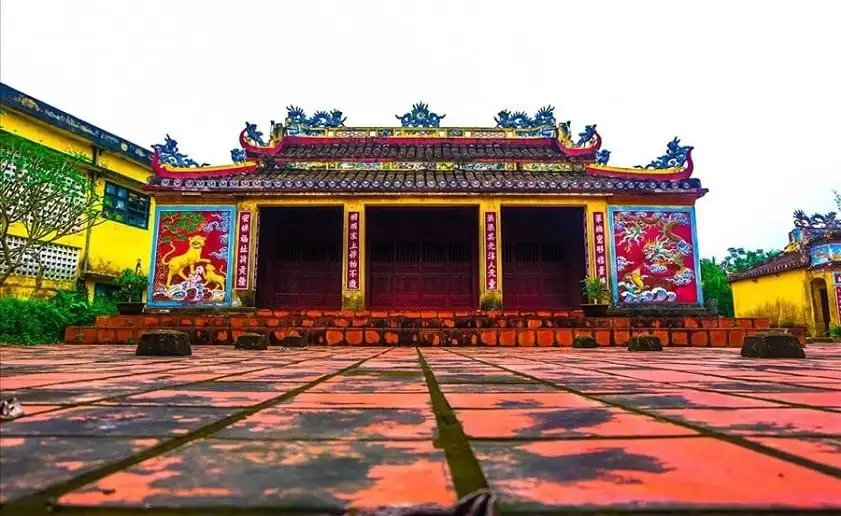
Beyond the communal house, Tuy Loan still retains many ancient houses dating back several generations. Most are built in the “three-compartment, two-wing” style, featuring low roofs, jackfruit wood frames, and earthen walls that maintain natural coolness. These structures, along with the communal house, have been recognized as city-level historical and cultural relics, representing the harmony between architecture, spirituality, and rural life.
Today, despite rapid urbanization in Da Nang, Tuy Loan continues to preserve its timeless charm and rustic beauty. The villagers take immense pride in their rich heritage and remain committed to safeguarding traditional crafts, local festivals, and age-old customs that define their cultural identity and connect them deeply to their ancestors.
Architecture and landscape of Tuy Loan Ancient Village
As visitors step into Tuy Loan Ancient Village, they are greeted by a serene rural scene where time seems to slow down. The gentle sound of the river, the shadow of ancient trees, and the sight of moss-covered tiled roofs create an atmosphere that feels both nostalgic and deeply authentic. The architecture here not only reflects centuries of craftsmanship but also embodies the harmony between people and nature, a balance that defines the soul of Vietnamese countryside life.
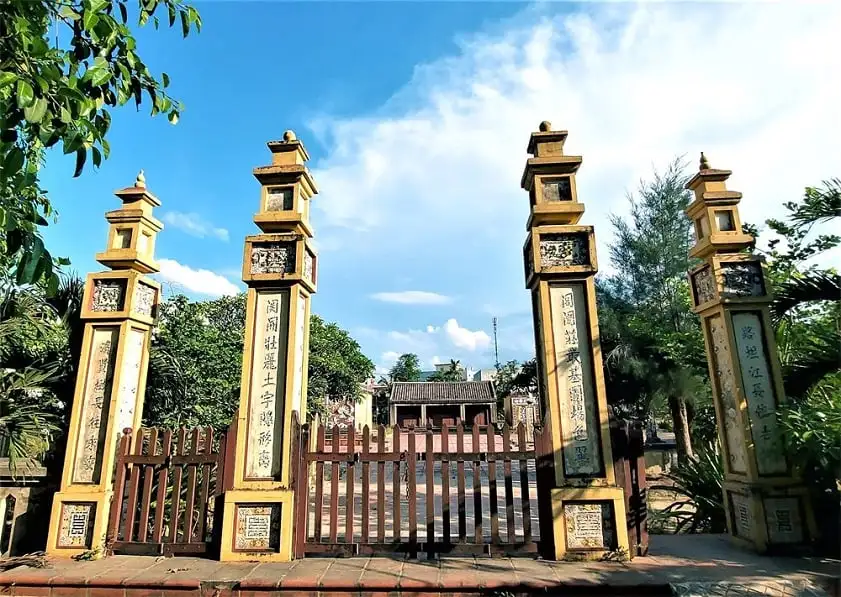
Traditional architectural style
The traditional houses in Tuy Loan are precious remnants of Vietnam’s ancient rural architecture. Most of them were built more than a century ago, following the “three compartments and two wings” (ba gian hai chái) structure typical of central Vietnam. The roofs are covered with yin–yang tiles, while the pillars, beams, and frames are made of jackfruit wood or ironwood, chosen for their durability and pleasant natural scent.
Each wooden pillar is intricately carved with patterns of dragons, phoenixes, and lotus flowers, symbols of wealth, virtue, and purity. The walls are made of earth mixed with straw, keeping the interiors cool in summer and warm in winter. In front of every house lies a small courtyard with stone paths, bonsai pots, and betel nut trees, where elders often sit to drink tea and chat, evoking a peaceful rhythm of rural life that has remained unchanged for generations.
The natural setting and village landscape
Tuy Loan’s landscape is as poetic as its history. The Tuy Loan River meanders gracefully around the village, providing water for the rice fields and serving as a mirror that reflects the tranquil scenery. Along its banks, lush bamboo groves and old bridges evoke images of a peaceful Vietnamese countryside frozen in time.
Small village lanes, shaded by areca palms and tamarind trees, lead to open rice paddies and vegetable gardens. In the early morning, the mist hovers above the water, and locals can be seen cycling to the market or carrying bundles of rice paper to dry in the sun, a daily rhythm that embodies the quiet charm of rural Da Nang.
Things you need to know before visiting Cam Ne Mat Village
Located about 15 km from Da Nang City Center and 35 km from Hoi An Ancient Town, Cam Ne Mat Village is an ideal half-day trip for travelers who love to explore traditional craft villages. This quiet rural area is known for its centuries-old mat weaving tradition, preserved through generations of local artisans.
How to get there?
Tuy Loan Ancient Village is located about 15 kilometers southwest of Da Nang city center and approximately 45–50 kilometers from Hoi An Ancient Town. With this convenient distance, travelers can easily plan a half-day or full-day trip combining both Da Nang and Hoi An’s cultural highlights.
From Da Nang, the easiest way to reach the village is by following National Highway 14B toward Hoa Vang District. The journey takes only 30–40 minutes by motorbike or private car, offering scenic views of peaceful countryside roads lined with rice paddies and small local houses. From Hoi An, the trip takes about 1.5 hours (roughly 50 km) via Vo Chi Cong Street – Da Nang City Center – National Highway 14B.
For a smooth and worry-free experience, Bliss Hoi An offers private transfer services directly to Tuy Loan Ancient Village. Guests can enjoy a comfortable ride through the countryside, with flexible pickup times and the option to combine the visit with other nearby attractions such as Cam Ne Mat Village or Hoa Phong Communal House.
Best time to visit
The village opens daily from 7:00 AM to 5:00 PM, and it’s best to visit in the early morning when the air is cool and villagers begin their day weaving mats. If you want to see the most lively scene, plan your visit between April and August, when the weather is dry and families are busy producing mats for domestic and export markets.
To avoid crowds and enjoy a more authentic experience, come on weekdays rather than weekends. If you’re staying in Hoi An or Da Nang, Bliss Hoi An offers convenient round-trip transfer services, allowing you to relax and enjoy the journey through peaceful countryside scenery.
If you wish to experience the rice paper–making season, plan your trip between March and August. These are the sunniest months of the year, when villagers dry rice papers outdoors, creating a beautiful golden hue across the courtyards. The busiest time in local households is early morning from 6:00 to 9:00 AM, when rice is ground, steamed, and the paper is spread out to dry. This is the best window to witness the authentic craft in action and capture stunning photographs under the morning sunlight.
Things to do when visiting Tuy Loan ancient village
With over 500 years of history, Tuy Loan Ancient Village preserves not only its time-worn architecture but also the daily rhythms of traditional village life. From exploring historical relics to tasting authentic local dishes and watching villagers make rice paper by hand, every experience here reveals a piece of Da Nang’s soul that modern life has yet to touch. Whether you’re seeking culture, cuisine, or quiet countryside charm, Tuy Loan promises a journey both meaningful and unforgettable.
Visit Tuy Loan Communal House and learn about local heritage
Built in the 15th century, Tuy Loan Communal House (Đình Tuy Loan) is the heart of the village. It’s dedicated to the village’s founders and serves as a cultural hub where community gatherings, ceremonies, and traditional games take place. You can admire the ancient architecture, and listen to stories from villagers about how the communal house has stood firm through wars and time.
Taste Tuy Loan famous Quang noodles
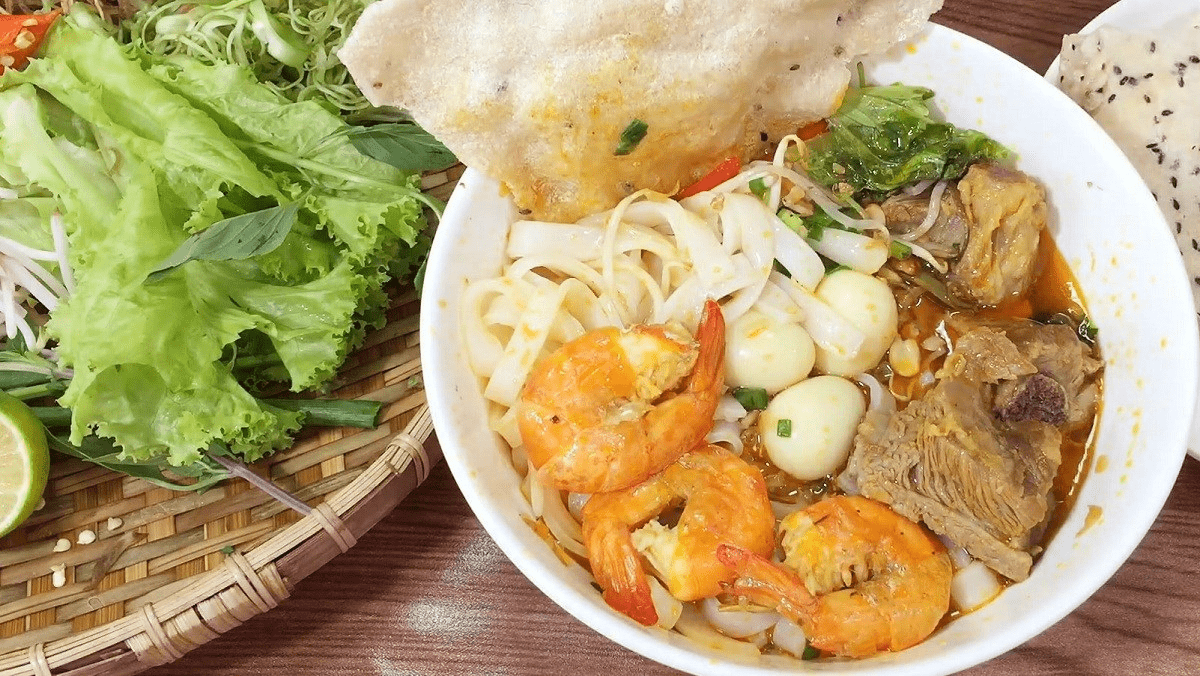
No trip to Tuy Loan is complete without trying Mi Quang Tuy Loan, a beloved local specialty said to be among the oldest versions of Quang noodles in Da Nang. The noodles are made from locally milled rice, topped with shrimp, pork, and quail eggs, and flavored with a rich turmeric broth. Many family-run eateries in the village have been serving this dish for generations, giving it a rustic and authentic taste you won’t find elsewhere.
Watch the locals make traditional rice paper
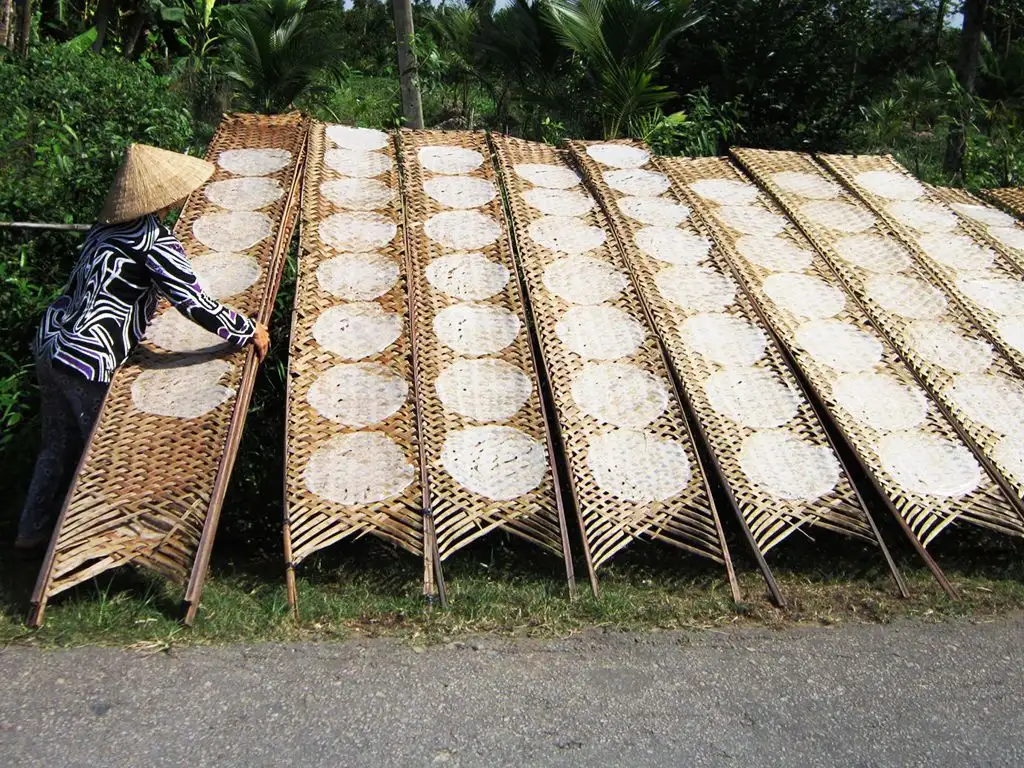
Tuy Loan is also known for its rice paper craft, a proud village tradition for over 500 years. Walking through the alleys, you’ll see villagers spreading thin layers of rice batter onto bamboo frames, drying them under the sun, and carefully roasting them over charcoal. You can join in the process, from grinding rice to flipping the paper over the fire and even bring home a few crispy rice papers as tasty souvenirs.
Join local festivals and traditional games
If you visit during the Tuy Loan Village Festival (usually held on the 9th day of the 1st lunar month), you’ll witness a vibrant celebration filled with music, folk games, and ancestral worship rituals. Locals dress in traditional costumes, play tug-of-war, wrestling, and boat racing, recreating the joyful spirit of the past. It’s a wonderful time to see how culture and community blend harmoniously in this centuries-old village.
Explore the century-old Tuy Loan Market
Tuy Loan Market is the lively heart of the village, where locals gather daily to trade produce, food, and handcrafted goods. The market has existed for more than 500 years, growing alongside the village itself. Here, visitors can immerse themselves in the sounds and colors of rural life.
What makes Tuy Loan Market special is its authenticity, nothing feels staged for tourists. Early in the morning, the market is at its most vibrant, as villagers sell freshly made Mi Quang Tuy Loan and rice paper straight from their homes. You can also sample local snacks such as sweet corn pudding or steamed banana cakes wrapped in leaves. The market is a great place to chat with the friendly villagers, learn about their daily routines, and even pick up handmade souvenirs like bamboo baskets or woven hats.
Visit the Tich Thien Duong Old House
Another fascinating spot in Tuy Loan Ancient Village is the Tich Thien Duong Old House, one of the oldest surviving traditional houses in the area. Built more than 200 years ago, the house features a distinctive “nha ruong” architecture, a wooden frame joined entirely by mortise and tenon joints without nails, resting on large stone bases. Its roof, made of old red tiles, and its elaborately carved beams tell stories of craftsmanship passed down through generations.

Visitors can explore the interior, which still preserves antique furniture, family altars, and traditional ceramics. The house offers a rare glimpse into how prosperous Vietnamese families once lived in the countryside. You’ll also get to meet the descendants of the original owners, who are always proud to share the history of their home and their ancestors’ contributions to the village.
For an even deeper experience, travelers can participate in tea-tasting sessions or cultural storytelling events occasionally hosted here, learning about the old customs, moral teachings, and the meaning behind the name “Tich Thien Duong” – “the place where good deeds accumulate.” It’s a tranquil and inspiring stop that perfectly complements your journey through Tuy Loan’s timeless charm.
Traditional craft villages near Tuy Loan ancient village
Exploring Tuy Loan Ancient Village is even more rewarding when you extend your trip to the nearby craft villages. Each one preserves a different aspect of Vietnam’s cultural identity, from weaving and farming to carving and traditional art, all within easy reach from Da Nang or Hoi An.
Cam Ne Mat Village
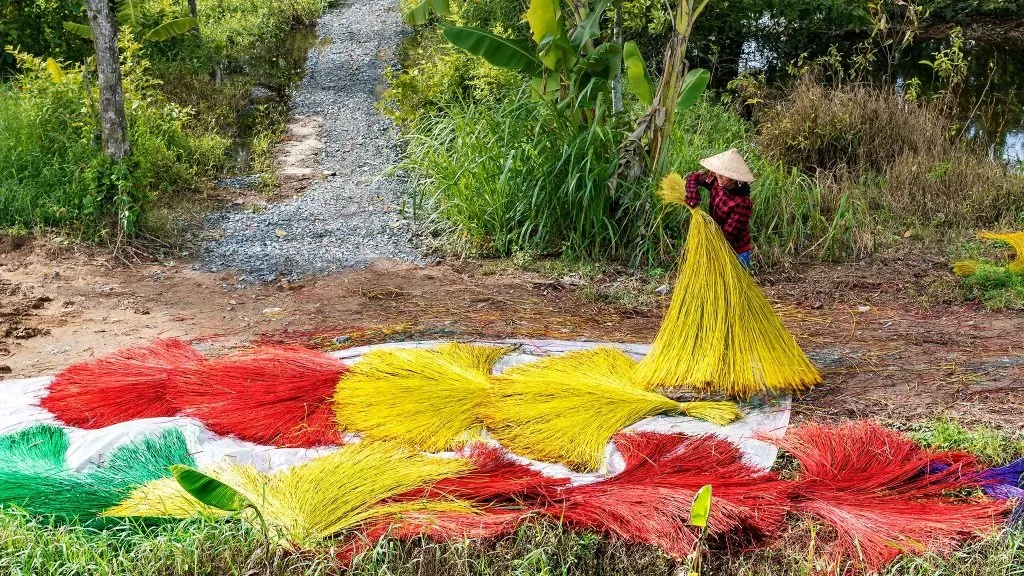
Located just 10 km from Tuy Loan, Cam Ne Mat Village is famous for its beautifully woven sedge mats, a symbol of Vietnamese rural life for centuries. Walking into the village, you’ll hear the rhythmic sound of looms as artisans weave mats in bright patterns and natural colors. Visitors can join in the weaving process, learn how the fibers are dyed and dried, and even bring home a handmade mat as a meaningful souvenir. This village has supplied mats to royal families in the Nguyen Dynasty, making it not only a craft site but also a piece of history.
Read more: Cam Ne Mat Village – Discover Da Nang’s ancient mat-weaving tradition
Tra Que Vegetable Village
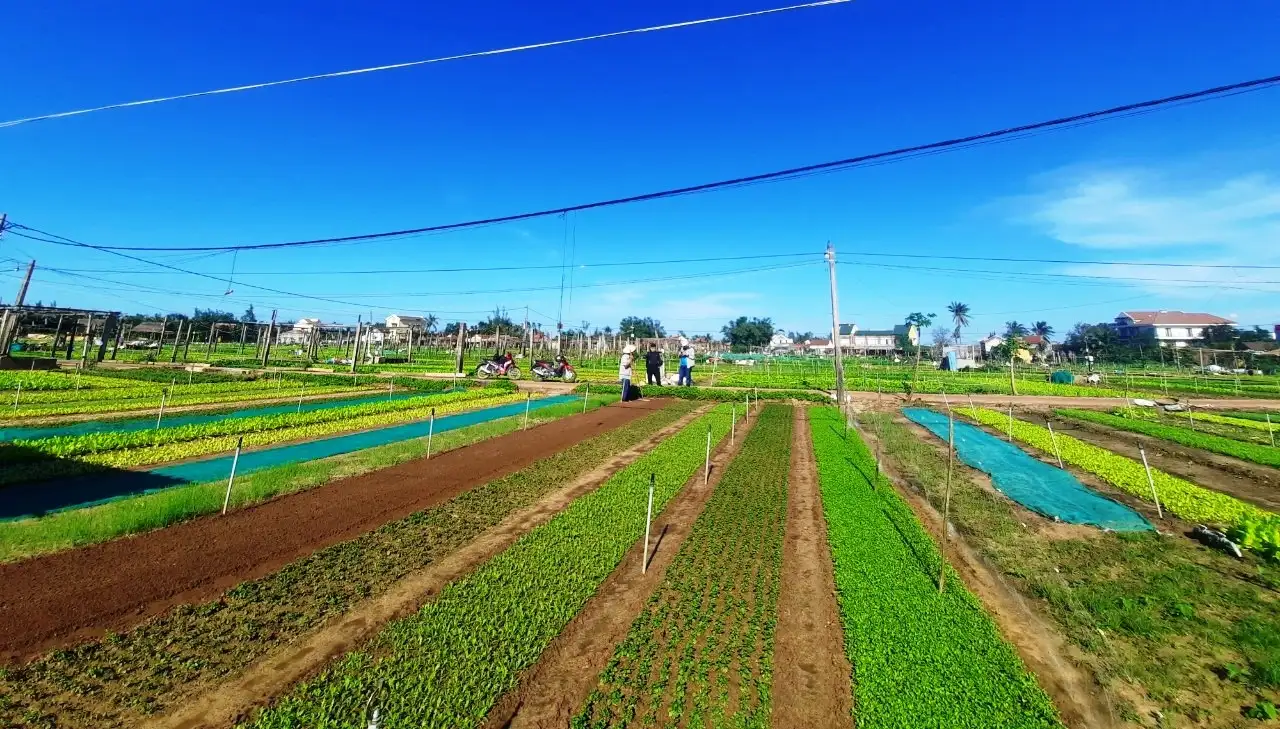
About 20 km from Tuy Loan, Tra Que Vegetable Village is a lush farming community between Hoi An and Da Nang, known for its organic herbs and traditional cultivation methods. Visitors can walk through green gardens, learn how farmers fertilize with seaweed, and experience hands-on farming activities such as watering, sowing, or harvesting.
Bliss Hoi An Beach Resort & Wellness offers a variety of countryside experiences that combine culture, food, and adventure. Among the most popular options are the Tra Que Vespa Tour and Traditional Cooking Class, designed to bring travelers closer to the soul of Central Vietnam. Hop on a vintage Vespa and ride through peaceful rural roads, passing golden rice fields and riverside paths as you make your way from Tuy Loan to Tra Que Vegetable Village. Along the journey, you’ll stop at local homes, traditional workshops, and hidden spots that most tourists miss.
Once you arrive in Tra Que, join the hands-on cooking class led by local chefs, pick fresh herbs from the garden, and learn the secrets behind Hoi An’s signature dishes. Book your tour today with Bliss Coriege!
Read more: Tra Que Vegetable village Hoi An: An ultimate travel guide
Non Nuoc Stone Carving Village
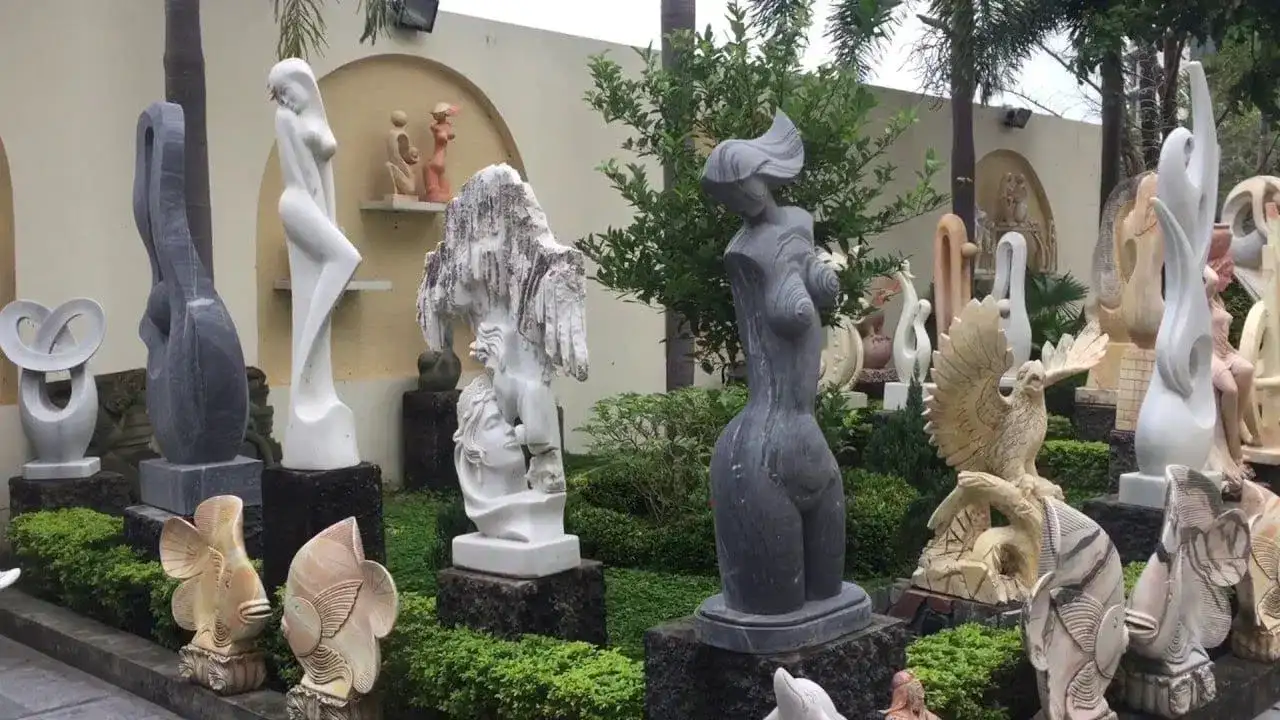
Roughly 25 km from Tuy Loan village, at the foot of the Marble Mountains, lies Non Nuoc Stone Carving Village, one of Vietnam’s most iconic craft communities. Here, artisans have been sculpting marble for over 400 years, transforming raw stone into delicate statues, jewelry, and home décor. You can watch skilled craftsmen at work, chiseling intricate details into every piece, or visit showrooms displaying stunning sculptures inspired by nature and spirituality. The artistry here reflects a unique blend of patience, skill, and deep cultural symbolism.
With its quiet charm, historical relics, and welcoming spirit, Tuy Loan Ancient Village offers a rare glimpse into Da Nang’s authentic countryside, where tradition and simplicity endure through generations. From visiting the communal house and Tich Thien Duong Old House to tasting Quang noodles and exploring nearby craft villages, each experience here brings you closer to Vietnam’s cultural soul.








